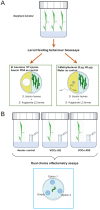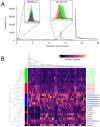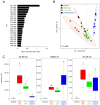Volatile Semiochemicals Emitted by Beauveria bassiana Modulate Larval Feeding Behavior and Food Choice Preference in Spodoptera frugiperda (Lepidoptera: Noctuidae)
- PMID: 38921424
- PMCID: PMC11204931
- DOI: 10.3390/jof10060438
Volatile Semiochemicals Emitted by Beauveria bassiana Modulate Larval Feeding Behavior and Food Choice Preference in Spodoptera frugiperda (Lepidoptera: Noctuidae)
Abstract
Beauveria bassiana is an entomopathogenic fungus that parasitizes and kills insects. The role of volatile organic compounds (VOCs) emitted by B. bassiana acting as semiochemicals during its interaction with lepidopterans is poorly explored. Here, we studied the effect of VOCs from B. bassiana and 3-methylbutanol (as a single compound) on the feeding behavior of L2 larvae of Spodoptera frugiperda in sorghum plants. Additionally, we assessed whether fungal VOCs induce chemical modifications in the plants that affect larval food preferences. Metabolomic profiling of plant tissues was performed by mass spectrometry and bioassays in a dual-choice olfactometer. The results showed that the larval feeding behavior was affected by the B. bassiana strain AI2, showing that the insect response is strain-specific. Furthermore, 80 µg of 3-methylbutanol affected the number of bites. The larval feeding choice was dependent on the background context. Fragment spectra and a matching precursor ion mass of 165.882 m/z enabled the putative identification of 4-coumaric acid in sorghum leaves exposed to fungal VOCs, which may be associated with larval deterrent responses. These results provide valuable insights into the bipartite interaction of B. bassiana with lepidopterans through VOC emission, with the plant as a mediator of the interaction.
Keywords: UPLC-MS; fungal volatiles; fusel alcohols; insect behavior; olfactometry; semiochemicals.
Conflict of interest statement
The authors declare no conflict of interest.
Figures






Similar articles
-
Volatiles released by Beauveria bassiana induce oviposition behavior in the fall armyworm Spodoptera frugiperda (Lepidoptera: Noctuidae).FEMS Microbiol Ecol. 2022 Oct 10;98(10):fiac114. doi: 10.1093/femsec/fiac114. FEMS Microbiol Ecol. 2022. PMID: 36166365
-
Reconstruction of Gut Bacteria in Spodoptera frugiperda Infected by Beauveria bassiana Affects the Survival of Host Pest.J Fungi (Basel). 2023 Sep 6;9(9):906. doi: 10.3390/jof9090906. J Fungi (Basel). 2023. PMID: 37755014 Free PMC article.
-
Pathogenicity of Beauveria bassiana PfBb and Immune Responses of a Non-Target Host, Spodoptera frugiperda (Lepidoptera: Noctuidae).Insects. 2022 Oct 8;13(10):914. doi: 10.3390/insects13100914. Insects. 2022. PMID: 36292862 Free PMC article.
-
Attraction of Myzus persicae (Hemiptera: Aphididae) to Volatiles Emitted From the Entomopathogenic Fungus Beauveria bassiana.Environ Entomol. 2023 Feb 17;52(1):31-38. doi: 10.1093/ee/nvac100. Environ Entomol. 2023. PMID: 36421055
-
Impact of Beauveria bassiana on antioxidant enzyme activities and metabolomic profiles of Spodoptera frugiperda.J Invertebr Pathol. 2023 Jun;198:107929. doi: 10.1016/j.jip.2023.107929. Epub 2023 Apr 29. J Invertebr Pathol. 2023. PMID: 37127135
Cited by
-
Microbial Volatile Organic Compounds: Insights into Plant Defense.Plants (Basel). 2024 Jul 23;13(15):2013. doi: 10.3390/plants13152013. Plants (Basel). 2024. PMID: 39124131 Free PMC article. Review.
References
-
- Drijfhout F. Encyclopedia of Life Science. John Wiley & Sons, Ltd.; Hoboken, NJ, USA: 2017. Chemical Ecology; pp. 1–11.
-
- Flores-Cortez I., Winkler R., Ramírez-Ordorica A., Elizarraraz-Anaya M.I.C., Carrillo-Rayas M.T., Valencia-Cantero E., Macías-Rodríguez L. A Mass Spectrometry-Based Study Shows That Volatiles Emitted by Arthrobacter agilis UMCV2 Increase the Content of Brassinosteroids in Medicago truncatula in Response to Iron Deficiency Stress. Molecules. 2019;24:3011. doi: 10.3390/molecules24163011. - DOI - PMC - PubMed
-
- Bruck D.J. Fungal Entomopathogens in the Rhizosphere. BioControl. 2010;55:103–112. doi: 10.1007/s10526-009-9236-7. - DOI
Grants and funding
LinkOut - more resources
Full Text Sources

